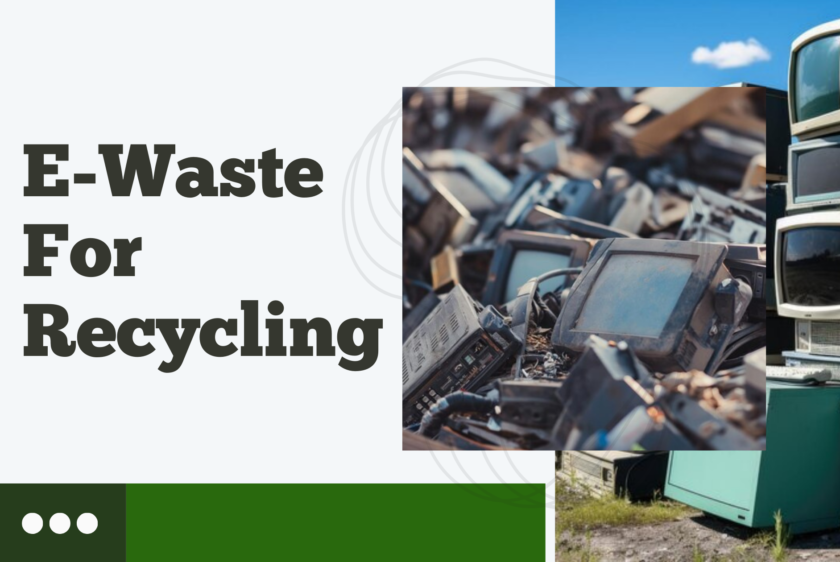
Best Practices for Storing and Transporting E-Waste For Recycling
We all know the importance of recycling our everyday waste, but what about the rapidly growing electronic waste, or e-waste, we discard each year? Old computers, phones, and TVs contain hazardous components that can destroy our health and environment if handled improperly. So, what happens after we stop using that outdated phone? The truth is many of them end up in landfills, and it all starts with how we store and transport them. In this blog, we will share the best practices for storing and transporting e-waste for recycling.
Importance of Proper E-Waste Handling Before Recycling
Proper e-waste handling is crucial for several reasons. It protects the environment by preventing hazardous components like lead, cadmium, and mercury from contaminating soil and water. This practice also safeguards human health by minimizing exposure to toxic materials, which can cause serious health issues. Effective e-waste management conserves valuable resources by enabling the recovery and reuse of precious metals. It reduces the need for new raw materials.
Additionally, it ensures compliance with local and international regulations, avoids legal issues, and promotes corporate responsibility. Therefore, responsible e-waste handling is essential for environmental protection, public health, resource conservation, and regulatory compliance.
Discover effective Ways for Storing E-Waste Before Recycling

Designate a Storage Area
• Location: Pick a location that is easily accessible yet secure to prevent unauthorized access. The area should be separate from other types of waste to avoid cross-contamination.
• Environment: Ensure the storage area is well-ventilated and dry. High humidity and poor ventilation can cause e-waste to deteriorate, leading to hazardous leaks.
Use Appropriate Containers
• Material: Use containers made of durable materials that are resistant to moisture and corrosion. Plastic bins with lids are a good option.
• Labeling: Clearly label each container with “E-Waste” and include details of the contents. This helps identify and sort e-waste for recycling.
Avoid Piling
• Organization: Place e-waste items in an orderly manner. Avoid stacking items to prevent crushing and damage. Store smaller items on shelves or racks.
• Accessibility: Arrange items to be easily accessible for inventory checks and transportation.
Remove Batteries
• Safety: Remove batteries from devices to prevent leaks and reduce the risk of fires—store batteries separately in containers designed for hazardous materials.
• Special Handling: For lithium batteries, take extra precautions as they are prone to catching fire. Store them in cool and dry spaces away from direct sunlight.
Protect from Elements
• Shelter: Ensure the storage area is protected from rain, direct sunlight, and extreme temperatures. Exposure to these elements can cause e-waste to break down and release toxins.
• Insulation: If the storage area is outdoors, use tarps or covers to protect the e-waste from weather conditions.
Inventory Management
• Tracking: Keep a detailed inventory of all stored e-waste. Include information such as the item type, quantity, storage date, and condition.
• Regular Audits: Run regular audits to ensure the inventory is accurate and to check the condition of stored items.
Practical Ways for Transporting E-Waste For Recycling
Transporting e-waste requires careful planning and execution to avoid environmental harm and ensure compliance with regulations. Here are the best practices for transporting e-waste:
Plan Ahead
• Scheduling: Establish a regular schedule for e-waste transportation to prevent the accumulation of large volumes of waste. Coordinate with recyclers to ensure timely pickups.
• Preparation: Prepare all necessary documentation and permits for transporting e-waste, including manifests, bills of lading, and hazardous waste permits.
Use Professional Services
• Licensed Transporters: Hire licensed and insured transportation services specializing in e-waste or e-waste management companies in India. They are knowledgeable about handling hazardous materials and complying with regulations.
• Reputation: Choose transporters with a good reputation and proven track record. Analyze reviews and ask for references if necessary.
Secure Packaging
• Padding: Use padding materials like bubble wrap, foam, or cardboard to protect fragile items during transit.
• Sealed Containers: Place e-waste in sealed containers to prevent spills and exposure. Ensure containers are not overfilled to avoid damage.
Label Shipments
• Clear Labels: Label all packages clearly with “E-Waste” and provide details about the contents and any handling instructions. This ensures proper treatment by handlers and transporters.
• Hazard Symbols: Include appropriate hazard symbols and warnings if the e-waste contains hazardous materials.
Comply with Regulations
• Local and International Laws: Familiarize yourself with local, state, and international regulations regarding the transportation of e-waste. Ensure all activities comply with these laws.
• Documentation: Keep all necessary documentation readily available during transport. This includes permits, licenses, and manifests.
Track Shipments
• Tracking Systems: Use GPS tracking systems to monitor the movement of e-waste shipments in real-time. This helps ensure the waste reaches its destination safely.
• Chain of Custody: Maintain a chain of custody documentation to track who handles the e-waste at each stage of the transportation process.
Conclusion
Proper storage and transportation of e-waste are critical steps in the recycling process. By following these best practices, individuals and organizations can contribute to environmental sustainability and ensure the safe handling of electronic waste. Remember, responsible e-waste management protects the environment and conserves valuable resources for future use.
Implementing these practices can significantly improve the environment and support the growing efforts toward sustainable e-waste recycling.
Read Our More Blogs:
Impact of E-Waste on Developing Countries
E-Waste Management in Developed vs. Developing Countries
Follow us:







